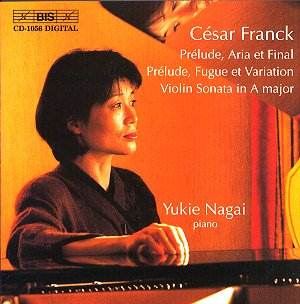Most pianists with a taste for the romantic and for
things French have fallen under the spell of César Franck’s Prélude,
Choral et Fugue, a work whose combination of fervour, mysticism
and sure-fire effect make it unique. Though most of its performers express
regret that Franck wrote so little for piano, only a few of them go
on to learn the later Prélude, Aria et Final (it’s got
a quiet ending and the lengthy opening movement can seem laboured, though
it doesn’t here). So this is the "other" piano work coupled
with two remarkably successful attempts to enlarge the Franck repertoire
of solo pieces.
The Prélude, Fugue et Variation, originally
an organ work, is considerably earlier, and of more modest proportions,
than the two piano triptychs. A transcription for piano by Harold Bauer
is fairly well-known; this one by the great virtuoso pianist Ignaz Friedman
treats it very simply. Organ music usually sounds quite ghastly on the
piano; what we have here convinces completely as piano music.
Even more surprising is the success of the violin sonata.
The fact that it has been successfully (well, fairly) transferred to
cello and flute (and for all I know it might have been played on the
saxophone too) should have told us that this is a great piece of music
that happened to be written for violin and piano, rather than a piece
born from the very nature of the two instruments. I put this on expecting
it to be a mere curiosity, but I sat back and listened with open ears
(and without the score of the original in front of me) and I can only
say I never really felt the absence of the violin.
Part of this is due to a performance so good that I
can only wish half of the violinists I have heard in this work had shown
so much understanding of it. I had never heard of Yukie Nagai, but perhaps
I have had my head buried in the sand, for as long ago as 1977 she won
the Geneva International Piano Competition and her teachers include
Wilhelm Kempff. Perhaps this last fact explains how, throughout the
programme, the music always seems to flow effortlessly from her fingers,
never mannered, always clear in direction and always drawing the right
contrapuntal line from Franck’s teeming textures. The canons in the
last movement of the sonata are just as clear as they are with two instruments.
Franck’s fervour gets its head without degenerating into feverishness,
the gentler moments are all the sweeter for flowing gently forward.
This is the sort of natural musicianship that doesn’t make the headlines;
so much the worse for the headlines.
I didn’t find the recording ideally richer, but it’s
good enough and I forgot any reservations as I got caught up in the
music.
Christopher Howell


